Oh and a recap to the reactions from my class on my hut project: I found it somewhat amusing that no one really got the concept I built my hut around. It was more interesting to see all the different reactions to it, one person said it reminded them of little forts they used to build as kids (me too!), and another said it really was a physical realization of the fear that many college students have graduating of ending up living in a cardboard box (or in this case a tent made of clothes) being unsuccessful at life. I love how it generated so many reactions.
Anyway, onto what I have been working on over the weekend, another TUTORIAL!! I've been meaning to do another one for a while, but wasn't sure what to do it on. But then it struck me, as I was trying to think of a neat print to make for some cards, duh, make a tute on some printmaking techniques that are awesome and easily done at home! So here it is guys. With LOTS of pictures.
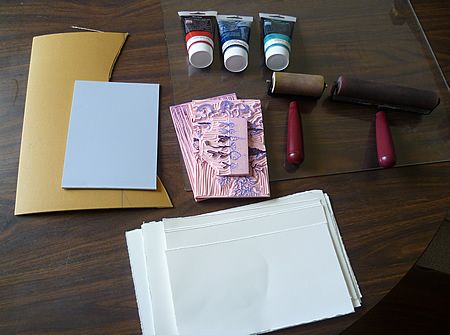
Everything you'll need:
-your choice of linoleum
-sharpie and/or pencil
-cutter
-water-based block printing ink
-brayer
-plexiglass or other hard surface that is washable
-paper
First of all you need to pick out your material. There's so many under the sun to choose from but I pulled some out of my stash to share with you.
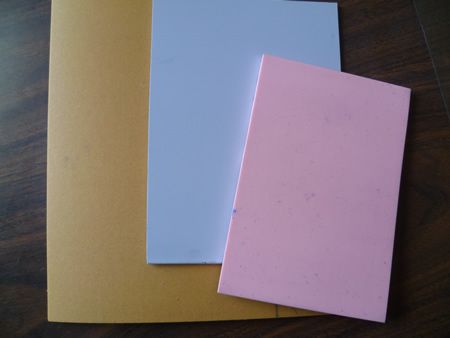
The one on the bottom is Golden Cut lino, which is pretty tough to carve. It's not impossible but nothing like the cut-through-like-butter lino you'd find in the typical craft store. It does have benefits like the ability to carve intricate textures that are more difficult to achieve on softer lino, but for at home purposes I probably wouldn't suggest it (I just pulled it out because that's what we used in my printmaking class and I had scraps left over).
The second type I have is Blue Easy-To-Cut Lino. It's actually a nice medium between the super soft speedy cut linos (pink and white/gray type) and the golden cut. It's a bit more plasticy in texture which makes it more resilient to careless carving. My only complaint with this one is it is rather thin, and as I tend to carve deeply I often cut right through the lino making holes. Not the end of the world but it's a bit of a hassel.
The last one I have in the picture is Speedy Carve pink lino which is my favorite lino to carve with at home. It is soft but still has a little bit of resilience to it. It kind of feels like you're carving rubber so as long as you take care not to go crazy fast with a cutting blade you have a fair amount of control with it, without having to kill you wrists carving. Now if you don't have any of these linos or don't want to shell out the money for them (some are more expensive than others) there are a lot of other materials that will give you a similar effect like erasers. I just prefer the lino because it gives you so much more room to work if you feel like working bigger =) Oh also as a side note: I'd be wary of the gray and/or white kinds. I've had ones that were similar to the speedy carve pink kind and were great, but more often than not they crumbled way to easily and didn't have the elasticity that speedy carve has - I wouldn't recommend it.
You will also need a cutter (sorry forgot to get a picture of that!). They come with a variety of different blade sizes and shapes which are handy depending on the type of carving and detail you are working on. Now to the actual carving! Here's our lino.

I drew a fun little design in sharpie to guide my blade as I carve. Pencil also works too but I like the bold lines a sharpie gives. First step is to carve the outline of everything with the smallest cutter blade you have (#1 or Liner blade). For a simple design like this it doesn't take too long, but for something more complicated, you'll be using the smallest blade for a while to get all the little corners and angles cut out.
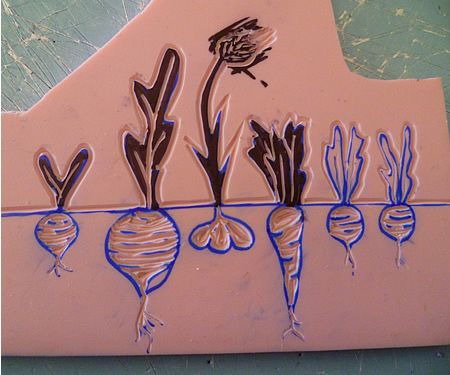
You can also see that I've filled in some of the leaves with more sharpie. It helps me to do that so when I'm doing the detailing of the leaves I can see the shapes I'm creating as I carve. Sometimes it helps to fill in areas with color so that you can better visualize the way it will print.

Next I took out my biggest, widest cutter (#5 or Large Gouge blade) and carved away all the "waste" area, or large areas that need to be carved away quickly. Take care to stay away from the detail work as the large blade can easily ruin it by accidentally slicing through it.
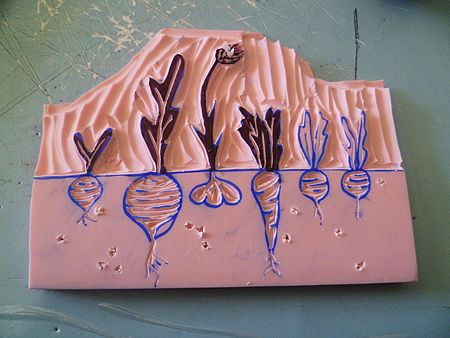
Next I used the second smallest blade (#2 or V-Gouge blade) to cut away the remaining lino. All done with carving! Now to print!

Squeeze out a little bit of the ink onto your plexiglass (or substitute) and roll it out so that you have fully coated your brayer.

Apply to the lino, making sure it is fully covered with ink.
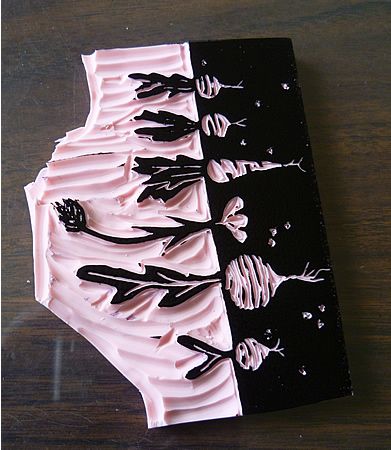
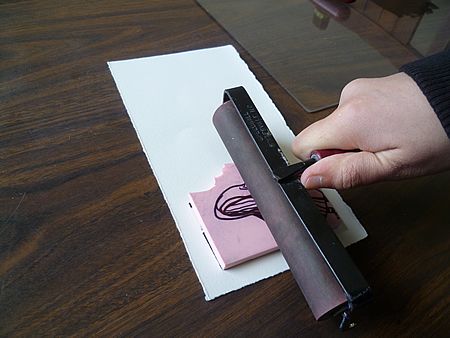
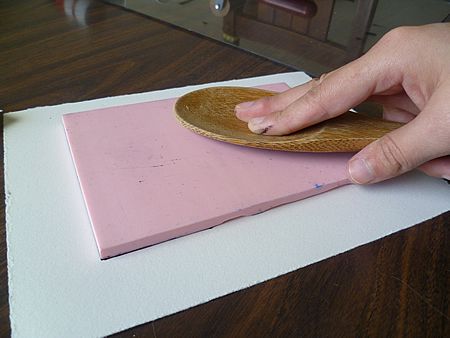
Press it face down onto your paper and use another brayer, a spoon, or your hands to apply pressure transferring the image to your paper.

You can gently pick up the lino to see how well the image has transferred - hold down the lino on one side so it doesn't move if you have to place it back down; if it hasn't make a clean print yet, keep rubbing! Here's our completed print! Maybe a little too much ink as it has a bit of a smooshed look to it, and not crisp lines, but not bad!
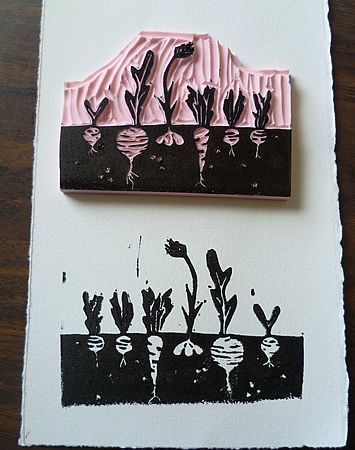
Here's some more pictures of another block I was working on to give you an idea.
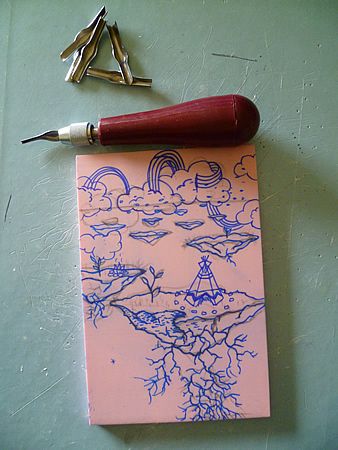
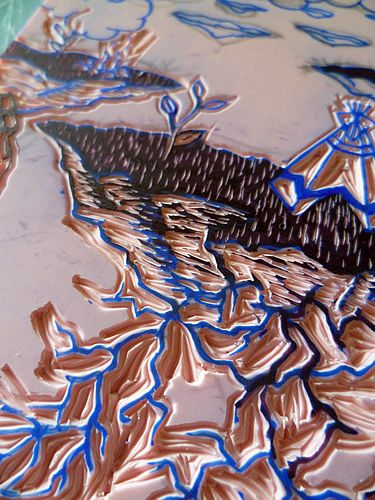
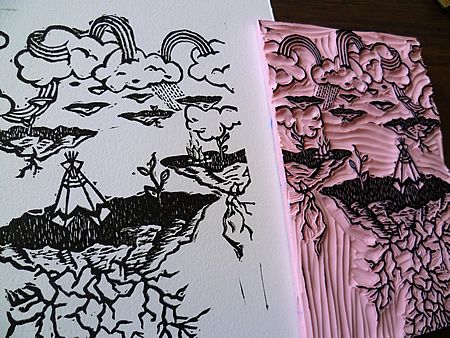
Happy printing!

I remember doing these in high school art class and really enjoying the process and the end result! I might have to try this again since I have all the tools from recent stamp carving attempts :). Thanks for the great tutorial.
ReplyDeleteAnd congrats on finishing school!! Whoo hoo!!!
Beautifully details description of your process.
ReplyDelete